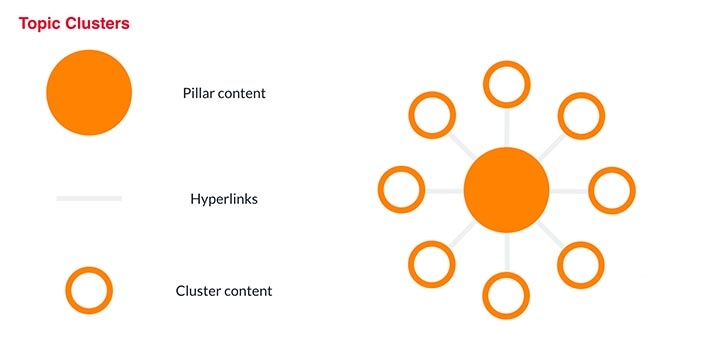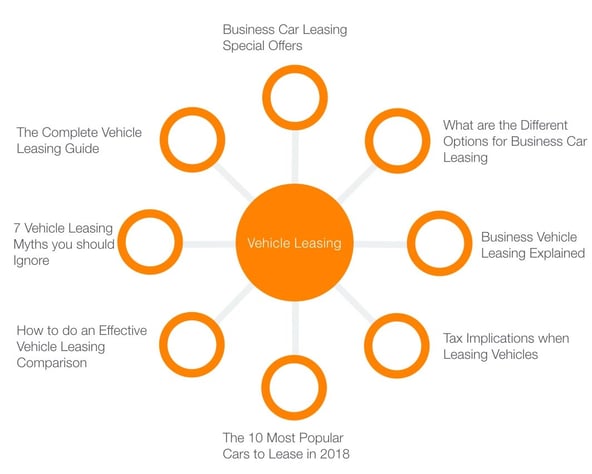Why Topic Clusters are the Next Big SEO Evolution
Why Topic Clusters are the Next Big SEO Evolution
Get weekly
HubSpot Updates
SEO has changed drastically over the last few years, and one of the most dramatic shifts is the move away from keywords to topics. This is due to Google (and the other search engines) having a greater understanding of semantics — or the meaning of language.
Keywords are still important, but industry professionals are now seeing greater success where a single ‘pillar’ page acts as the main hub of content for an overarching topic and elsewhere on the site (and possibly on external domains), while several related content pages refer back to the pillar page (and to each other) using hyperlinks.
This hyperlink highlights to search engines that the pillar/hub page is an authority on the topic and, over time, the page may rank higher for the topic (and therefore a multitude of keywords) it covers.
The topic cluster model, is an attempt at structuring a website’s pages using an architecture where there is less cannibalisation (multiple pages competing for the same term), whilst also ensuring semantic relevance across a broad range of content types.
The topic cluster model is illustrated below:
 As you can see, the pillar content is the focal piece. This piece of content should target several related keywords or phrases. Other articles or content pieces (targeting long-tail keywords) should then all hyperlink back to this piece of hub or pillar content.
As you can see, the pillar content is the focal piece. This piece of content should target several related keywords or phrases. Other articles or content pieces (targeting long-tail keywords) should then all hyperlink back to this piece of hub or pillar content.
It is well known that Google uses external links to determine the authority of a particular web page, and there are several articles that suggest internal linking is also an important SEO factor. At its very core, this makes sense. The more you link to one particular article within your own website, the more you want people to read it.
How does this affect new & existing content generation?
The overall stance is to think about topics — not keywords. In terms of existing content, a thorough audit needs to be conducted to group articles, posts, graphics, etc. into different related buckets. Once you have grouped them together, carry out keyword research to work out if any of the existing pages could be used as your pillar content. If not, you will need to create your pillar content. You should also seek to improve/optimise any existing content based off the aforementioned keyword research.Once this is complete, you need to ensure you are interlinking between the pages, paying particular attention to your pillar page. You can then use your keyword research to create further cluster content that links back to your main pillar content. This process can be repeated across several topic clusters.
A topic cluster example

Vehicle leasing: 4,400 searches per month
In the example above, the core topic is ‘vehicle leasing’ with over 4,400 searches per month. Each of the surrounding subtopics focuses on a more specific branch of the core topic, for example, ‘business vehicle
leasing explained’.
The objective of pillar content is to cover the main topic quite broadly and also convert visitors into leads (or whatever your conversion goal is). This could often be in the form of a content download. The supporting cluster content that is created for each of the additional topics (long tail keywords) will focus on gaining greater topic awareness and visibility, whilst funneling users through to the pillar content to try and get those visitors to convert.
How to get started with topic clusters
HubSpot have some useful advice for getting started on developing a topic cluster strategy:
- Map out five to ten core problems that your buyer persona has. Use surveys, run interviews, and do some secondary research within online communities to gather the data.
- Group each of the problems into broad topic areas.
- Build out each of the core topics with subtopics using keyword research.
- Map out content ideas that align with each of the core topics and corresponding subtopics.
- Validate each idea with industry and competitive research.
- Create content, measure the impact, and refine.
The key to the successful implementation of topic clusters is this planning phase, making sure you have clearly outlined the topic and pillar page, and then all the supplementary/supporting content. Aligning each of these content pieces to the most appropriate keyword(s) will then help your reporting process, as you can then align each article and track and monitor success appropriately.
Our content includes affiliate links. This means that we may receive a commission if you make a purchase through one of the links on our website. This will be at no cost to you and helps to fund the content creation work on our website.